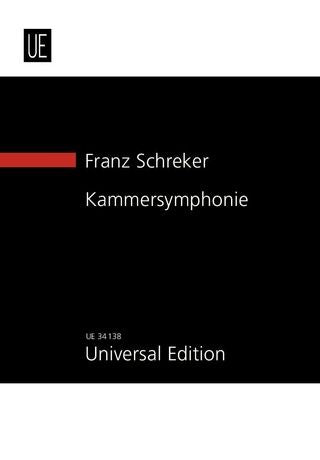
UNIVERSAL EDS/WIENER/PRESSER - 864872
Schreker Chamber Symphony for 7 wind Instruments, 11 strings, harp, celeste, harmonium, piano, timpani and percussion
Composer: Franz Schreker
Publisher: Universal Edition
Format: Study Score
Schreker Chamber Symphony for 7 wind Instruments, 11 strings, harp, celeste, harmonium, piano, timpani and percussion
Juilliard Store
144 West 66th Street
New York NY 10023
United States
Choose options

Schreker Chamber Symphony for 7 wind Instruments, 11 strings, harp, celeste, harmonium, piano, timpani and percussion
Juilliard Store
144 West 66th Street
New York NY 10023
United States
Schreker Chamber Symphony for 7 wind Instruments, 11 strings, harp, celeste, harmonium, piano, timpani and percussion
Juilliard Store
144 West 66th Street
New York NY 10023
United States
In a letter to Paul Bekker from 22 August 1918, Franz Schreker (1878-1934) wrote of his sometimes “desperate battles” with instrumentation. “One realizes that there should really be many more instruments. I don’t mean more within the categories we have, but new ones. I often hear sounds that can scarcely be realized with existing means.” Klang, or sound, was a central category of Schreker’s creative persona. His visions were timbral, his complex emotional insights captured in the iridescence of his orchestra. It is an orchestra made up not of individual instruments – ”nothing,” he once wrote, “is more disturbing to me than, for example, a celesta intruding as such – but a dematerialized array of ever-changing colors.”
No work better captures this sonic ideal than his Chamber Symphony, written in 1916 in celebration of the centenary of the Vienna Academy and given its premiere there in March 1917. Its shimmering opening, in which first the flute, then the violins float above the aural mists of celesta, harmonium, piano and harp, is music of otherworldly magic. Schreker’s instrumentation refracts thematic ideas through the prism of his orchestra. Lines intertwine, motives move imperceptibly from one instrument to another, transforming a trumpet into a clarinet, wedding the harmonium with a bassoon. And just as thematic ideas give up something of their material autonomy to become immaterial color, formal articulation is blurred through Schreker’s love of mercurial shifts of mood, tempo, and rhythm. The four sections within this single-movement work – an introduction, main movement, adagio, and scherzo – frequently overlap and, with the exception of the scherzo, are all recalled at the end.
By its title and formal aspirations, the Chamber Symphony appears to be one of Schreker’s very few works of “absolute” music, yet one cannot overhear the manifold thematic relationships with his opera Die Gezeichneten or with gestures (especially in the scherzo) related to his pre-war ballet and pantomime scores. More importantly, one finds in the Chamber Symphony motivic vestiges of Schreker’s unfinished opera of 1915, Die tönenden Sphären. That, significantly, is the story of a man who collects sounds.
Schreker’s own reputation as an aural fantast and collector of sounds became a heavy burden in the 1920s. A younger generation that had once pored over his rich and complex scores now embraced music that was lean, angular, and dissonant. Both Hindemith and Weill, for instance, knew and performed Schreker’s music and had gone through their “Schreker phase”. But the sweet lures of late Romantic harmony and orchestral color were no match for the purifying flames of Expressionism. Ironically, these forces were transforming Schreker’s own style during the very same years. With his Expressionist opera, Irrelohe, written 1919-22 and given its premiere under Otto Klemperer in 1924, Schreker’s music likewise became leaner and more astringent. The world that had given rise to his Chamber Symphony had vanished and in its place new sounds awaited discovery.
Christopher Hailey
